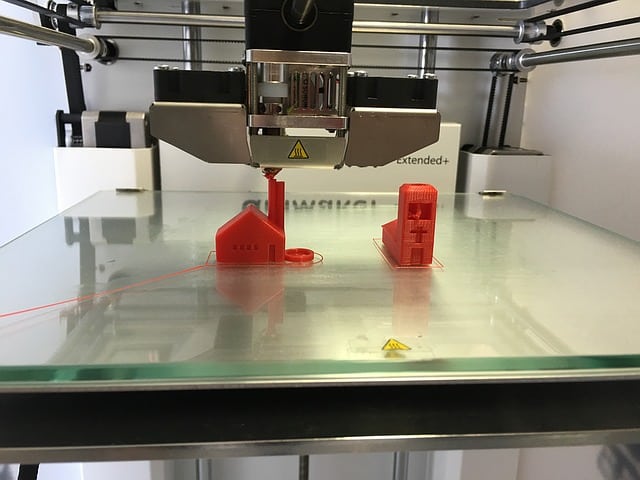
Professor Behrokh Khoshnevis of the University of South Carolina developed a Fused Deposit Modeling (FDM) 3D printer. He mounted the machine on top of a robotic arm that ejects layers of concrete to build walls or other objects. In other words, the print head is controlled by a computer that defines the shape of the print. And the cool thing is that this additive manufacturing technology has all the needed traits to be used in the construction industry. It increases the construction speed, reduces injuries in the workplace, and minimizes both the waste and cost. The benefits of 3D printers in industrial settings can easily lead to new technology replacing traditional construction methods, including the design of networks topologies.
And obviously, it’s not only big constructions that benefit from the novel technology. A 3D printer can also make smaller items like showerheads, combination locks, and gaming miniatures. You can print figurines for tabletop games like Dungeons & Dragons or make a cool 3D Viking to bring you good luck when playing Viking Age.
But to understand better how 3D printing is making a revolution in construction, let’s take a closer look at how a 3D printer works in this sector in 2020. Ready?
Contents
Robot Extruder
So how exactly is it possible to create sizeable 3D models with an even surface? It’s all done by a robotic arm installed on rails on the construction ground. It extrudes the concrete one layer at a time while moving back and forth. This method of depositing the construction material is called Contour Crafting.
And to make sure the model stands firmly, the layers are flattened by trowels above and on the sides of the robotic arm’s nozzle. Needless to say, this can not be done with standard concrete as it hardens too quickly to finish the process. Luckily, we’ve got a special type of concrete made specifically for construction 3D printers with large print areas. This special type of concrete combines the benefits of self-compacting and spraying concrete. Unfortunately, the exact consistency of the mix is kept in secret at the moment.
3D Printing of Sand
3D printing of sand was first tested by Enrico Dini, an Italian architect. He built a D-shaped machine that lays out a layer of sand and then uses a binder to harden the shape. A similar 3D printer is also used in printing metal.
Printing Metal
Building structures like bridges needs materials that can hold out against more stress. The Wire Arc Additive Manufacturing robot enables to print metal structures utilizing six axes (the standard for most industrial robots). It’s developed by a Dutch company MX3D by combining a welding machine with an industrial robot. The result is a 3D printer that’s powered by the company’s own software.
The Key Benefits of a 3D printer in construction
The main reason why construction giants have shown great interest in adopting 3D printing technology is that it’s economical. The additive processes mean that the construction can be completed with much less materials. Also, because there’s much less waste produced, the environmental impact will be lowered. As the geometric mastery of machines and programs increases, the shapes can be further optimized to minimize the amount of material needed.
One of the biggest concerns in the construction industry is that the largest 3D printers at the moment are used by WASP, an Italian company dedicated to using only green energy. Their construction further benefits the environment (and lowers the costs even more) by using local materials only. The huge amount of emission has been a big concern for the construction industry, and 3D printing can help to alleviate these problems.
Not yet officially recognized as a construction method
So can we soon expect to see skyscrapers coming out of 3D printers? Not quite. Although it would be theoretically possible to print out a 100-story building, there are still many standards and codes that wouldn’t allow that kind of construction. And for a very simple reason: it’s too difficult to realize calculations of resistance in time with such novel structures. At the moment, we can only test the houses on a case-by-case basis. There’s not enough satisfactory evidence for the standard bodies that the 3D printed structures can hold out against their environment.
Luckily, there are no major limitations in building smaller items. And the best part is that there are a lot of people willing to pay money for these products.
3D Printers for Home Use: a Great Money-Making Opportunity
3D printing has become a hot topic in 2020, and many individuals (and businesses) would love to get their hands on some 3D objects. But they don’t always have the necessary equipment since an average 3D printer costs too much. Here’s where you can come to help. If you’ve managed to purchase a printer to your home, you can easily set up a 3D printer business.
And the best part is that using the 3D printer for making miniatures is quite easy. And there’s no trouble selling them online via various marketplace communities. Everyone can build a site for their eCommerce ventures and start advertising the products on Facebook.
But what to print? Well, some best-selling items are little fantasy figurines for tabletop games like Dungeons and Dragons. You can start with simpler designs and as you get better, start printing items in more detail.
Conclusion
The bottom line is this: the 3D printer is used for manufacturing items quickly and with minimal waste. This advantage can be used in construction to build something as big as a house. E-commerce entrepreneurs can set up their printing businesses from home, making game figurines. Whichever the case, the eco-friendliness and minimized costs of this novel technology make it a safe bet for your business’s future. So start using this cutting-edge technology today and give yourself the best chances to succeed.
Do you think 3D printing will replace the traditional construction methods by 2030? Write down your opinions in the comments section. We’d love to continue the discussion.
Author’s Bio
Alex Norwood is an experienced traveler and an online entrepreneur. He is very interested in technology and tries to implement it in his life. He runs a successful eCommerce business and is always on the lookout for new lucrative ways to make money online.

1 thought on “Construction 3D Printing: How It Works Today”